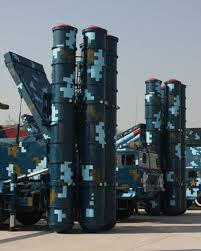
Missile Defense with Chinese Characteristics
Publication: China Brief Volume: 13 Issue: 11
By:

On January 27, 2013, China conducted its second mid-course missile defense interceptor test, leading to considerable speculation among Chinese and Western analysts about Beijing’s motives and intentions as well as its plans for further development of mid-course intercept technology and possible deployment of its own missile defense system. Given Beijing’s longstanding and vehement opposition to U.S. missile defense programs—which it charges damages strategic stability and undermines China’s security by raising doubts about the effectiveness of its nuclear deterrent—it would seem logical that China would refrain from pursuing similar capabilities (“China Steps Up Rhetoric Against U.S. Missile Defense,” China Brief, October 19, 2012). Somewhat ironically, however, even as Chinese officials have continued to criticize the United States for conducting research on and activities related to missile defense, China has been developing its own missile defense technology. Indeed, over the past three years, Beijing has conducted two missile defense interception tests—both of which were accompanied by brief official statements—and Chinese analysts have suggested a number of potential directions for China’s missile defense program.
China’s Missile Defense Interception Tests
China conducted the first of its two missile defense interception tests on January 11, 2010. China’s official Xinhua News Service released a brief statement that provided only very limited information on the test. The statement read “On January 11, 2010, China conducted a test on ground-based midcourse missile interception technology within its territory. The test has achieved the expected objective. The test is defensive in nature and is not targeted at any country” (Xinhua, January 11, 2010). At a Foreign Ministry press conference the next day, a spokeswoman repeated the themes contained in the brief official statement that followed the test. In an attempt to distinguish it from China’s January 2007 ASAT test, the spokeswoman added that the missile defense test did not leave any debris in space or pose a threat to the safety of any orbiting spacecraft (Xinhua, January 12, 2010). Beijing’s strategic communication plan following the January 2010 missile defense interceptor test clearly represented a major improvement compared to the confusion and awkward silence that followed China’s January 2007 ASAT test, but Chinese official and unofficial statements still left many key questions unanswered [1].
Following China’s second missile defense interception test, which was conducted in January 2013, Chinese official media carried a brief report confirming that it had taken place, but the statement provided only limited information on the results and almost no insight into China’s rationale for the development of its own missile defense technology. The report stated that China “again carried out a land-based mid-course missile interception test within its territory.” It quoted a Ministry of National Defense spokesman, who stated the test was “defensive in nature” and not targeted at any other country, and indicated the test “reached the preset goal” (Xinhua, January 28). The report also described the test as similar to the one that China successfully carried out in January 2010, but offered no further details. Other official media reports echoed the theme that the test was defensive and was not targeted at any specific country.
Another theme highlighted by some official media reports was the technical complexity of China’s missile defense tests. One Xinhua report stated that such tests demonstrate “highly complicated technologies in detecting, tracking and destroying a ballistic missile flying in the [sic] outer space.” The report described the successful anti-missile test, “together with a string of other military equipment progress,” including the sea trials of China’s first aircraft carrier and the test flight of a developmental large transport aircraft, as a reflection of China’s growing military power. Specifically, it stated these developments “demonstrated the country’s fast-growing ability to defend its own national security and deter any possible threats" (Xinhua, January 28). In addition, separate media reports lauded Beijing’s disclosure of the test as a sign of China’s “increasing transparency in military affairs” (Xinhua, January 28). Yet the official reports provided no insight into the strategic rationale for China’s investment in missile defense technology, the PLA’s plans for future tests or Beijing’s thinking about the potential operational deployment of missile defense systems.
Motives and Implications
Although China publicly announced both of its missile defense tests, it has not provided any official explanation of its motives for the development of missile defense technology or its plans for the deployment of missile defense capabilities. Chinese official statements thus have raised more questions than they have answered. Nonetheless, knowledgeable Chinese observers suggest there are at least three paths Beijing could follow in the future: (1) continue to refine its missile defense technology while refraining from deploying an operational system; (2) deploy a national missile defense system intended to protect the entire country, at least from a small-scale ballistic missile attack (like the current U.S. national missile defense system); or (3) deploy a small number of missile defense interceptors in a point defense role, to provide some level of protection for key strategic targets such as its ICBMs or strategic command and control facilities [2].
As for the first potential way forward, following China’s second missile defense test, Li Bin, a well-known Chinese scholar who specializes in nuclear strategy and arms control issues, suggested that Beijing was likely focusing on technology development in an attempt to “assess capabilities” rather than planning to deploy a national missile defense system. Furthermore, in Li’s words, “China’s 2010 and 2013 missile intercept tests demonstrated that the country had acquired [hit-to-kill] technology, but that does not mean China has a conceptual missile defense system that can target incoming missiles from any specific country.”
Perhaps the least likely outcome would be deployment of a full-scale national missile defense system. As Li Bin puts it, “In the U.S.-Chinese context, it would be very inefficient for China to deploy a national missile defense system to counter U.S. offensive nuclear forces. If the Chinese want to use a national missile defense system to limit the damage caused by U.S. strategic missiles, they will need many more interceptors than the United States would need for the same purpose. China would have to pay much more money than United States to build up its capability. Moreover, such a missile defense system, if it contained enough interceptors, would have broader costs as well—the same negative impact as the U.S. national missile defense system currently does on U.S.-Chinese strategic stability.” Even one modeled after that of the United States and capable only of intercepting a small number of incoming warheads would seem to be a poor fit for China’s strategic circumstances.
If Chinese leaders intend to deploy an operational missile defense system, a point defense system designed to defend a handful of small areas against ballistic missile attack would seem a more logical and affordable approach. According to Li Bin, a point defense system would represent “a much more reasonable choice than a national missile defense system for China if it decides to develop its hit-to-kill technology into a missile defense system.” Li suggests that a point defense system could be used to protect Chinese command and control centers, and thus to ensure that “Chinese political and military leaders would survive a surprise preemptive nuclear strike so that they could direct a retaliatory nuclear strike.” According to Li, such a system “could also be used to protect some of China’s strategic nuclear weapons and increase their survivability.” Indeed, Li’s earlier work has highlighted the possibility that point defense systems could enhance the survivability of China’s silo-based ICBMs.
In contrast to the potentially destabilizing effects of a broader national missile defense system, Li writes, “a point defense system would make China’s nuclear deterrent more credible and ensure its strategic stability with other nuclear-armed countries.” This assessment appears to track closely with the post-test comments of military officers who suggested that defensive capabilities would improve the survivability of China’s strategic nuclear forces. Although none of these comments specified an exact role for China’s mid-course missile defense interceptors, they would appear to be consistent with their employment in a point defense role, probably protecting Chinese ICBMs. China’s approximately 20 silo-based ICBMs would seem to be the best candidates for this purpose, given that China presumably sees them as much more vulnerable to a first-strike than its road-mobile ICBMs. In addition, employing missile defense in this role could be less difficult—and less expensive—than trying to deploy even a limited national missile defense system. Indeed, Li Bin suggests that compared to a national system, a point defense system would have more modest technical requirements and a much lower cost.
If China pursues the deployment of a missile defense system, it will need more than ground-based interceptors. As Chinese analysts have noted, Beijing also will need complementary capabilities, such as ballistic missile early warning satellites (Hubei Daily, January 28). China currently lacks early warning satellites like the U.S. Defense Support Program (DSP) and Space-Based Infrared System (SBIRS) satellites.
As for the broader implications of China’s missile defense program, Chinese analysts suggest it will strengthen, rather than undermine strategic deterrence. Beijing continues to object to missile defense systems it sees as strategically destabilizing (most notably, those of the United States), but it apparently does not see its own missile defense system as problematic from this perspective. Indeed, Chinese analysts do not appear to be concerned that China’s development of missile defense will trigger an arms race. So long as China limits its missile defense deployments to a point defense role, continues to adhere to its longstanding “No First Use” (NFU) policy and maintains a nuclear force posture clearly oriented toward retaliatory missions, this thinking does not contradict China’s broader position on missile defense. Thus, Beijing can make the case that its own missile defense program is not inconsistent with its argument that missile defense systems potentially capable of negating an adversary’s strategic deterrent are destabilizing, especially when coupled with first strike doctrines and capabilities.
Underscoring the extent to which Beijing’s development of missile defense technology is linked to China’s other strategic weapons programs, some Chinese analysts have characterized China’s missile defense program as an emerging element of China’s overall strategic deterrence posture. For example, after the January 2013 missile defense test, Senior Colonel Shao Yongling of the PLA Second Artillery Force Command College told the official Communist Party newspaper People’s Daily that China’s development of mid-course missile intercept technology shows “the country’s strategic deterrence system is shifting from relying merely on offensive weapons to integrating offensive and defensive weapons.” Shao suggested that missile defense would allow China to continue to “maintain a relatively small number of nuclear weapons given its increasing defensive capabilities.” Specifically, in Shao’s words, “as long as enough nuclear weapons survive first-strike attacks, China can carry out nuclear retaliation against the attacker. Therefore, strong defensive capabilities are of great significance to the country’s national security” (People’s Daily, January 30).
China’s development of missile defense technology has received less attention from scholars who follow Chinese military modernization than Beijing’s modernization of its nuclear force and its development of offensive counter-space capabilities [3]. China’s two missile defense intercept tests—and the comments of Chinese analysts linking them to Beijing’s ongoing attempts to strengthen its strategic deterrence capabilities—however, suggest that U.S. analysts should pay very close attention to Chinese missile defense developments.
Notes:
-
James Mulvenon, “Evidence of Learning? Chinese Strategic Messaging Following the Missile Defense Intercept Test,” China Leadership Monitor, No. 31, available online <https://media.hoover.org/sites/default/files/documents/CLM31JCM.pdf>.
-
Li Bin, “What China’s Missile Intercept Test Means,” Carnegie Endowment for International Peace, February 4, 2013, available online <https://carnegieendowment.org/2013/02/04/what-china-s-missile-intercept-test-means/fa45>.
-
For one notable exception, see Kevin Pollpeter, “China’s Second Ballistic Missile Defense Test: A Search for Strategic Stability,” SITC Bulletin Analysis, February 2013, available online <https://igcc.ucsd.edu/assets/001/504391.pdf>.





